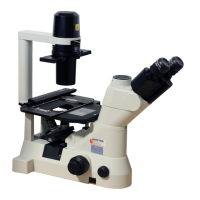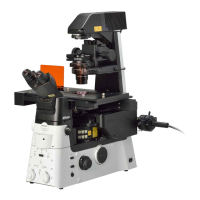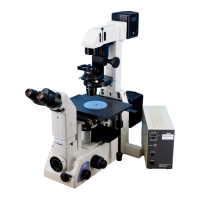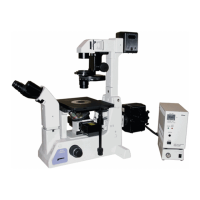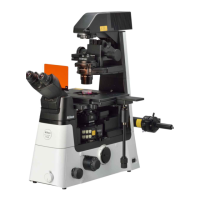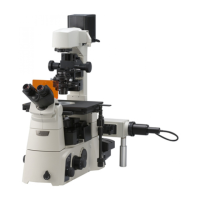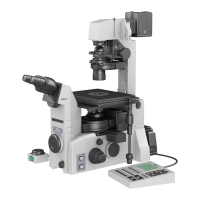4 Operation of Each Part
5 Objectives
E-27
3
Objective with correction ring
An inverted microscope is frequently used to observe specimens through the bottom plate (made
of glass or plastic) of a laboratory dish or culture bottle. For such applications, because the
bottom plate thickness differs, the normal objectives (for 0.17 mm thick cover glass) may not
provide clear images, disabling the microscope from demonstrating its full performances. In such
cases, use an objective with a correction ring to compensate for bottom plate thickness.
The objectives with correction rings are not intended to compensate for wedge-like changes of
thickness at edges of a container. We recommend that they should be used for compensation for
even thickness.
Adjusting the correction ring
(1) Adjust the scale of the correction ring to the thickness of the bottom plate of the container.
This thickness should be a measured value or the value stated by the container
manufacturer.
(2) Focus on the specimen with the focus knob.
(3) Rotate the correction ring clockwise or counterclockwise slightly if the image has poor
resolution and/or contrast. When the correction ring is rotated, the specimen image
becomes slightly out of focus. Adjust the focus again with the fine focus knob.
(4) If the resolution and contrast are improved, rotate the correction ring further in the same
direction, then adjust the focus again.
If the resolution and contrast are deteriorated, rotate the correction ring in the reverse
direction by the amount about double the previous turn, then adjust the focus.
In this way, rotate the correction ring in the same direction if a better image is obtained, or
rotate it in the reverse direction if a poor image is obtained. Repeat this operation to find
the best point.
The 0 mm position of the correction ring is used for microscopy of a specimen with no cover
glass.
We recommend that you take a note of the reading of a well-visible position on the correction
ring.
Your note should help when you later use containers having different bottom plate thickness.
4
Cover glass and slide glass thickness
A specified cover glass thickness is indicated on each objective. ("∞ /0.17" indicates a cover
glass thickness of 0.17 mm.)
For an objective with a 0.17 mark, place a specimen so that its cover glass (0.17 mm thick)
faces the objective. (For an inverted microscope, set a specimen so that its cover glass faces
down.) An objective with a 1.2 mark is for a slide glass with thickness of 1.2 mm. Place a
specimen so that its slide glass faces the objective. (For an inverted microscope, set a specimen
so that its cover glass faces up.)
When you observe a specimen in a laboratory dish or the like at high magnification through a
glass not conforming to the specified thickness, we recommend use of an objective that has a
correction ring capable of correcting the glass thickness error.
5
Oil immersion objectives
Objectives which have a black band around the tip and on which "Oil" is printed are oil
immersion objectives. Oil immersion objectives are used by filling Nikon immersion oil between
the tip of the objective and the specimen. Use non-fluorescent oil when performing fluorescence
microscopy with an oil immersion objective intended for fluorescence microscopy.
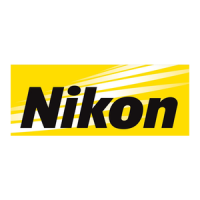
